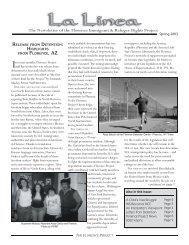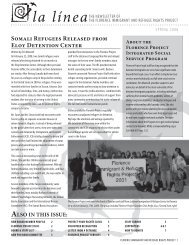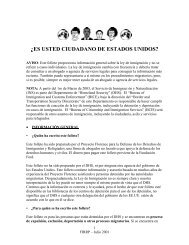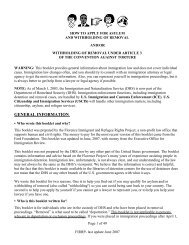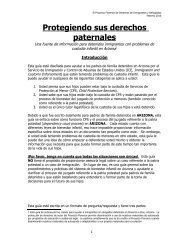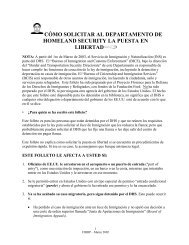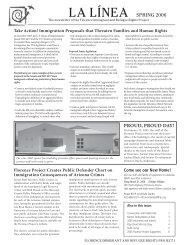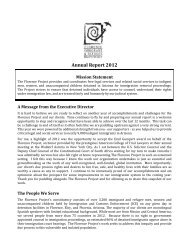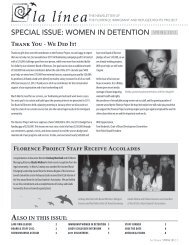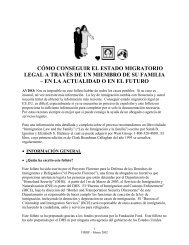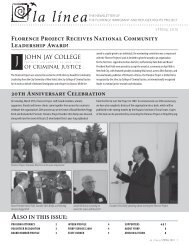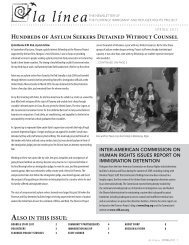quick reference chart and annotations for determining immigration ...
quick reference chart and annotations for determining immigration ...
quick reference chart and annotations for determining immigration ...
Create successful ePaper yourself
Turn your PDF publications into a flip-book with our unique Google optimized e-Paper software.
Immigrant Legal Resource Center, Florence Immigrant <strong>and</strong> Refugee Rights Project,<br />
Maricopa County Public Defender August 2012<br />
(9th Cir. 2012) (“it is well-settled that attempted aggravated assault under Arizona law covers only<br />
intentional conduct”) (citing State v. Kiles, 175 Ariz. 358, 857 P.2d 1212, 1224 (1993) (“[A]ttempt is a<br />
specific intent crime <strong>and</strong> by definition involves intentional conduct.”). There<strong>for</strong>e, in order to avoid a<br />
crime of violence or a crime of domestic violence, counsel would be better off pleading to a straight<br />
assault than an attempt in order to leave open the possibility of a reckless mens rea.<br />
Regarding the year’s sentence, simple assault under Arizona law is only punishable as a<br />
misdemeanor with a maximum sentence of six months. However, if a conviction <strong>for</strong> assault under § 13-<br />
1203 serves as the basis <strong>for</strong> an aggravated assault under § 13-1204, a sentence of one year or more could<br />
result in an aggravated felony.<br />
Other Grounds: Domestic Violence. To be a deportable domestic violence offense the<br />
conviction must be of (a) a crime of violence (b) committed against someone with whom the defendant<br />
had a domestic relationship, as established by the record of conviction. If one of these factors cannot be<br />
proved, the offense does not cause deportation under this ground. There is no requirement of a year’s<br />
sentence. See Note: Domestic Violence. In Fern<strong>and</strong>ez-Ruiz v. Gonzales, 466 F.3d 1121 (9th Cir. 2006)<br />
(en banc), the Ninth Circuit found that a conviction <strong>for</strong> a class 2 misdemeanor assault under § 13-1203<br />
did not categorically constitute a crime of violence under 18 U.S.C. § 16(a) since it involves recklessness<br />
under A1. There<strong>for</strong>e, a domestic violence conviction <strong>for</strong> simple assault under A1 is not categorically<br />
removable as a “crime of domestic violence” unless the government can prove that the offense was<br />
committed intentionally, rather than recklessly. However, the government has successfully argued that,<br />
since assault committed intentionally or knowingly is punishable as a class 1 misdemeanor under § 13-<br />
1203(B), any conviction <strong>for</strong> A1 as a class 1 misdemeanor will automatically be considered a “crime of<br />
violence.”<br />
A conviction under A2 coupled with a <strong>reference</strong> to 13-3601 will be a crime of domestic violence.<br />
Camacho-Cruz v. Holder, 621 F.3d 941, 943 (9th Cir. 2010) (“intentionally placing another person in<br />
reasonable apprehension of immediate bodily harm” is a crime of violence).<br />
In general, mere offensive touching under A3 is not a crime of violence. See Ortega-Mendez v.<br />
Gonzales, 450 F.3d 1010 (9th Cir. 2006) (finding Cali<strong>for</strong>nia Spousal Battery which includes offensive<br />
touching not crime of violence); Singh v. Ashcroft, 386 F. 3d 1228 (9th Cir. 2004) (Oregon harassment<br />
statute is not necessarily a crime of violence because it can be violated by mere offensive touching);<br />
Matter of Velasquez, 25 I&N Dec. 278 (BIA 2010); ); Flores-Lopez v. Holder, 685 F.3d 857 (9th Cir.<br />
2012) (Cali<strong>for</strong>nia “general intent” crime that employs offensive touching <strong>and</strong> a mens rea of recklessness<br />
is not categorically a “crime of violence” under section 16(b)). There<strong>for</strong>e, a plea to A3, even with a mens<br />
rea of “intentionally,” should not be held a categorical crime of violence.<br />
To avoid a crime of violence, counsel should plead to A1 as a class 2 or 3 misdemeanor, A3, or<br />
leave the record vague between subsections. Counsel should avoid pleading to A1 as a class one<br />
misdemeanor, or to A2. Where possible, counsel should also attempt to keep the record clear of<br />
in<strong>for</strong>mation that more than recklessness or mere offensive touching was involved.<br />
Note that a plea to attempted assault will always involve an intentional mens rea <strong>and</strong> thus<br />
preclude the benefits of a plea to recklessness. United States v. Gomez-Hern<strong>and</strong>ez, 680 F.3d 1171, 1176<br />
(9th Cir. 2012) (“it is well-settled that attempted aggravated assault under Arizona law covers only<br />
intentional conduct”) (citing State v. Kiles, 175 Ariz. 358, 857 P.2d 1212, 1224 (1993) (“[A]ttempt is a<br />
specific intent crime <strong>and</strong> by definition involves intentional conduct.”). There<strong>for</strong>e, in order to avoid a<br />
Arizona Criminal Chart with Explanatory Endnote – August 2012<br />
24



